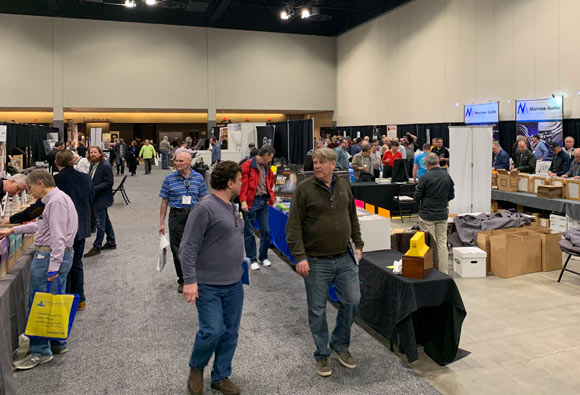2019: Another Year Ends
As we creep closer to the end of another year, I thought I would string together a few words reflecting some of the issues, trends, and observations that occurred during the past 12 months. As I see it, the audiophile world is being propelled by two opposing trends. The first is the irrational but continued growth and popularity of vinyl LPs and all of its associated paraphernalia — I have read that sales of vinyl will outpace compact discs for the first time in 2019. And second, the migration from physical optical, digital discs to high fidelity music streaming (notice I avoided saying high-resolution!).

Audiophiles had a choice in 2019. We could look backwards and embrace a highly compromised, expensive, inconvenient, sonically flawed format or revel in the reality of having access to any tune or album, anytime, anywhere, in CD quality for pennies a day. In spite of the marketing hyperbole, misinformation, and outright falsehoods put forth by this new. high quality streaming industry, the era of physical media is all but over. Vinyl LPs may be outselling CDs but that not because their numbers are overwhelming. It’s because no one is buying CD, DVD, or Blu-rays.
These two opposing trends are starkly represented in the marketplace ballrooms of every audiophile trade show. I attended and exhibited at almost every audio show over the past 12 months. Booth after booth were populated by vendors offering boxes full of vinyl LPs, expensive ultrasonic cleaning systems for discs, turntables, tone arms, exotic cables, rice paper sleeves, and specialized step transformers for exacting the last microdynamic of fidelity from the groove of an analog vinyl pressing. How many more times do we need a seminar on how to setup and align a turntable?

I have no doubt that advocates for vinyl LPs, turntables, and moving coil cartridges get great personal and musical satisfaction from their systems and luxuriate in the ritual of playing a favorite vinyl album. However, their preferred sound is at odds with the greatly increased potential represented by the newest audio technologies of our digital age. This is not an argument about which is better: subjective vs. objective listening. I would argue that it’s about what’s familiar and friendly. Specifications do matter!
Close friends of mine believe expensive power cords alter the fidelity of their systems, they continue meaningless rants about digital interconnects and isolation platforms being worthwhile expenditures for fidelity improvements, and they cling to the same tired excuses when challenged online or in editorials. How many times have I been told my hearing is failing, my system doesn’t have sufficient resolution, or I have a closed mind. My response is always that same. I’ve made my living as a professional audio and mastering engineer for over 40 years, headed the Audio Recording program at CSU Dominguez Hills for over 30 years, built and worked in a state-of-the-art multimillion dollar studio, and have willing to accept that my position on the merits of “high-resolution” (even my own bona fide examples) was most likely incorrect — and have changed my mind.
Services like Tidal, Pandora, Spotify, Qobuz, and Amazon Music HD represent the future of music listening. They may never appeal to traditional audiophiles — the mostly middle aged men that flock to the audio shows — but these new services have reached a level that makes them very attractive alternatives to physical media digital or analog. And they will only continue to improve. It’s time to move forward.
“Pre Hi-Res” Music
A few weeks ago, I noticed a comment on a submission request for the HD-Audio Challenge II form. The individual wrote:
“I’m not interested in your listening ‘challenge’, I’m just writing to explain how very very wrong you are in your assertions about ‘pre-hi res’ albums.
It is literally this simple: If the original analog master tape of a Jimi Hendrix album sounds better than a RedBook CD of that same (untouched) master (and only a tin-eared dolt would bother to argue that it WILL), then hi res DOES do a service to “pre-hi res” recordings by getting us closer to the sound of that master tape. PERIOD.”
I didn’t see the second sentence because the spreadsheet wasn’t wrapping multiline text, so I wrote and asked the individual for a little further clarification.
MW: I noticed your comment on the HD-Audio Challenge Submission form. I’m not sure I’m clear regarding your assertion that I’m “very very wrong” in my assessment of “pre-hi-res” albums. Can you state your objections more clearly? I’m always open to contrary opinions or facts…but need to understand what you’re contending.
I received the following:
RW: I think I was pretty clear in my message, but I’ll reiterate. You make the assertion that “hi res” is not a designation appropriate to albums recorded “before the era of hi res recording” (not actually a quote, but paraphrased here). You complained about sites like HD Tracks touting new issues of older albums as “high resolution” and “Ultra HD” that were recorded and released in an era before we had albums with a more “hi res” sound (I can only assume you mean sound of a certain frequency range that became substantially wider in commercial music in the late 70s), and that those earlier albums don’t merit their digital download files being designated as “high resolution” or “Ultra HD” because improving the quality of the digital version won’t give any additional fidelity to those albums.
You know what you were getting at. You articulated it quite clearly. And you were, and are, dead wrong.
High resolution playback is about getting us as close as possible to the experience of listening to the Master tape of an album — indeed, any and all such developments in playback technology aim for that target regardless of medium. The better the playback technology, the better that experience is replicated, and it makes no difference whatsoever whether a given recording needs ultra HD sound to deliver its sound in and of itself — it’s not about that. The limited dynamic and frequency ranges of commercial music of the early 70s (for example) are not what necessitate the HD technology; it’s about the playback technology being advanced enough to disappear from the equation entirely, leaving nothing but the (sometimes) stark reality of the music unfettered.
So there absolutely IS a reason for those records to be issued in the highest resolution and most advanced formats possible, and any issued versions produced with that goal in mind should absolutely be designated as such.
Proof? If any Master tape of any record sounds better than the vinyl records of it that were issued to the public, and better than the CDs of it that were eventually issued, then the same is true of ALL records ever produced in the entirety of post-WWII history — not just the ones you think sound really good.
I hope that was as clear as it was verbose.
A Reasoned Response
I asked the writer if I could post his emailed comments. He promised to edit some of it down but I never received a followup so I’m moving ahead. I was intrigued by the idea of “pre hi-res” music releases and his application of the prefix “pre” to indicate a period of album releases that existed prior to high-resolution capable recording equipment and release formats.
I think we can all agree that audio consumers want and deserve to have the very best sounding version of any album — including those recorded in the “pre hi-res” period. Digitizing older analog masters using PCM digital with sample rate higher than 48 kHz and word lengths longer than 16-bits guarantees that the capture container far exceeds the fidelity of the original analog master. However, I support archiving these aging masters at 96/24 PCM. Moving any further is pointless and a waste of storage space and bandwidth.
This is where my experience and expertise differ with the writer. He wrote:
If the original analog master tape of a Jimi Hendrix album sounds better than a RedBook CD of that same (untouched) master (and only a tin-eared dolt would bother to argue that it WILL), then hi res DOES do a service to “pre-hi res” recordings by getting us closer to the sound of that master tape. PERIOD.”
This statement seems to contradict itself. Or perhaps I’m misunderstanding. I think the writer wanted to say “and only a tin-eared dolt would bother to argue that it WON’T” . I’m reading the “it” in his statement to refer to the original master tape.
Let’s accept that the 2-channel master tape of a Jimi Hendrix delivers the ultimate listening experience for that album (never mind that in many cases the original master cannot be located and safety copies or dupe masters are used instead). The writer seems to infer that a straight, digitized version at 44.1 kHz/16-bits wouldn’t capture all of the fidelity of the original tape and therefore moving to 96/24 — so called “hi-res” — gets “us closer to the sound of the master tape” than the standard-resolution CD capture. This statement just isn’t supported by the facts. A good digital transfer of the original master tape to 44.1/16-bits would sound identical to the original master tape! If you believe otherwise, take the HD-Audio Challenge II and prove it you can “easily pick out” the hi-res versions as some have claimed.
All preliminary indications from the current HD-Audio Challenge II results would argue that no one can “easily” pick out a hi-res music selection over a CD “Redbook” version of the same master (There still time to participate. Please visit this article to get started.” The submissions thus far are well below 50% success.
Hi-res audio is NOT an adjective to be used to describe recordings captured so as retain as much of the original fidelity of the master tape as possible. In the years I spend on the high-end audio board of the CEA and the NARAS meetings, the goal was to define “hi-res” audio as an absolute measure of recording quality — kinda of like HD-Video or Ultra HD-Video. The definition agreed to by the organizations, labels, and consumer equipment manufacturers established recordings made using equipment “better than CDs” — 48 kHz/20 bits or greater — as deserving of the hi-res audio logo.It was this flawed definition that prompted me to introduce the concept of provenance with regards to audio production. Recording from the “pre hi-res” era will never meet the specifications established by the organization behind the standard — and logo. The fidelity of the original Jimi Hendrix master tape will never be “better than CD fidelity”. It just won’t because the equipment and processes used to produce it weren’t high-resolution. Does that diminish the value of Jimi’s work or the work of the engineers and producers that crafted those classic albums? Certainly not. But they will never be hi-res music. They are “pre hi-res” and will forever remain so.
This from a gentleman that is not interested in participating in the HD-Audio Challenge II.
A Last Minute Special Discount on the Paperback Version of the Book – 60% OFF
It’s been an incredible year? My Music and Audio: A User Guide to Better Sound was lauded as the “new gold standard” for books on high-end audio. Thousands of copies have sold to audiophile eager to learn more about the art and science of high-end audio. Listeners that want to maximize their listening pleasure without breaking the bank. For the next four days, I repeating the 60% Cyber Monday sale on the paperback version of the book. Take advantage of this unique opportunity. Use COUPON CODE MAAG60Percent during checkout.

And as an extra incentive, I’ll throw in a free downloadable album from the AIX Records catalog (samplers are not available as downloads) to the first 25 customers that take advantage of this offer. I’ll reach out to those that qualify by email.


Hi Mark.
Hope you and your family have enjoyed and are enjoying this holiday season.
I fully agree with you on all points you made in this blog.
We both know that all of the negative issues you discussed have come to be all in support of the almighty dollar.
I have no problem with folks how enjoy the ritual of playing LP’s but the whole “resurgence” deal was built on the lies and fairy-tales of the high end media regaling on the “superior” sound of vinyl. Nothing could be further from the truth and a simple comparison of the two medias specs fully reveals the emperor has no clothes. But the high end media has created a billion dollar industry built on a stack of stinkin BS. Numbers don’t tell the whole story they retort and Joe Turntable buys right into it.
The big issue to me over the death of optical media is that on the video side, what’s available from the streamers is not up to the quality that on the discs, specially on the audio side. BluRay and 4k discs are offering 6 to 9 channels of sound in 24/96 Dolby or DTS lossless. What’s coming from the streamers varies greatly but none of it come close to what’s on a optical disc. If easy access to movie discs like Redbox rentals disappears. the HT folk will be much poorer for it.
How many years now has it been since Peter Aczel wrote the following words, truer today than ever.
“The gullibility of audiophiles is what astonishes me the most, even after all these years. How is it possible, how did it ever happen, that they trust fairy-tale purveyors and mystic gurus more than reliable sources of scientific information?”
Yes, I think Mark’s article somewhat overlooks the paucity of surround sonics from the streaming music services. And that represents an unmistakable deficit in the sonic experience, compared to what optical discs offer.
OTOH there is the small matter of the paucity of MCH from the optical discs put on the market, too.
Oh well.
I, too, am convinced that your writer-conversant wanted to say “and only a tin-eared dolt would bother to argue that it WON’T”. And I’m afraid I wouldn’t have gotten much further than that sentence, combining as it does unveiled insult with incorrect premise about CD’s limit in terms of audible quality.
Life is too short to spend time dealing with that sort of aggression and unwillingness to listen or learn.
I do appreciate, Mark, your open-mindedness in learning from the tentative results of your HD Audio Challenges, flawed as they be by relying on an honour system. So many would have such fixity of mindset as to rail against the test because it didn’t tell them what they wanted to hear. Not you.
cheers
Most of us Audiophiles, who have a long history of watching live acts, and who have been striving to reproduce that live sound at home, have quite a different perspective of home sound production at its best. We all have smartphones, or most of us and a DB app. A live show of any Gendre will have dynamics and bandwidth far beyond the capabilities of pre-hi rez recording techniques. I employed dbx noise reductin early on with my Revox 2 channel tape deck. I used the expansion capabilities on all my vinyl playback, along with a SAE click and pop machine. When the 1st true16/44 CDs came to existence most of us were all blown away with the “more live like” performance of that format. Think Dire Straits 1st CD and Stevie Wonder’s ist CD Songs in the Key of Life. I was disc jockeying at the University of Toronto and post-grad with my Altec Voice of the theatres, Marantz power amps, and a regular DJ rig with the equipment mentioned above. When I graduated 8T1 I bought the Klipshorns and still have my 5.1 system centred around them. Your Aix 5.1 recordings are the closed thing that I have found to realistically produce Live recordings. They have become my reference standard. Still waiting for the extra $ to buy the entire collection. The individual in this Blog has never heard an ABX comparing, vinyl, tape, with true HD reproductions. When you have never heard the difference how can you make such right-wing definitive comments about anything?
Thanks Glen and Happy New Year